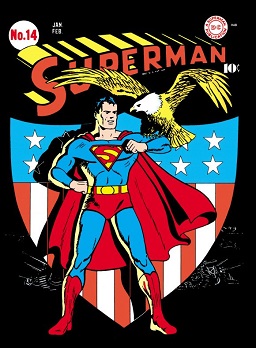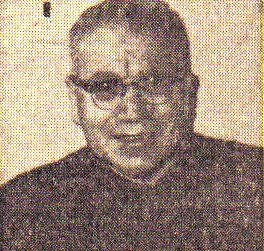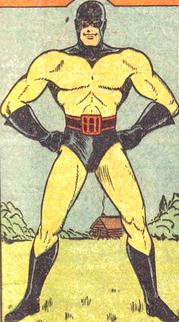
Archie Comic Publications, Inc., is an American comic book publisher headquartered in Pelham, New York. The company's many titles feature the fictional teenagers Archie Andrews, Jughead Jones, Betty Cooper, Veronica Lodge, Reggie Mantle, Sabrina Spellman, Josie and the Pussycats and Katy Keene. The company is also known for its long-running Sonic the Hedgehog comic series, which it published from 1992 until 2016.

The Golden Age of Comic Books describes an era in the history of American comic books from 1938 to 1956. During this time, modern comic books were first published and rapidly increased in popularity. The superhero archetype was created and many well-known characters were introduced, including Superman, Batman, Robin, Captain Marvel, Captain America, and Wonder Woman.

Irving Novick was an American comics artist who worked almost continuously from 1939 until the 1990s.

The Mighty Crusaders is a fictional superhero team published by Archie Comics. The team originally appeared in Fly-Man No. 31, #32 and No. 33 before being launched in its own title, The Mighty Crusaders. Written by Superman co-creator Jerry Siegel, the series lasted seven issues before being cancelled. The team was revived under Archie's Red Circle Comics line in 1983. In 1992 DC Comics licensed the characters and relaunched the team as The Crusaders, aiming the comic at younger readers as part of its !mpact line. This series lasted eight issues, cover-dated May to December 1992.

Dark Circle Comics is an imprint of Archie Comics Publications, Inc. Under its previous name, Red Circle Comics, it published non-humor characters, particularly superheroes in the 1970s and 1980s.

The Shield is the name of several superheroes created by MLJ. Appearing months before Captain America, the Shield has the distinction of being the first superhero with a costume based upon United States patriotic iconography. The character appeared in Pep Comics from issue #1 to #65.

Paul J. Reinman was an American comic book artist best known as one of Jack Kirby's frequent inkers during the period comics fans and historians call the Silver Age of Comic Books. This included the first issues of The Incredible Hulk and The X-Men.

The Black Hood is the name of several fictional characters created by MLJ Comics during the period known as the "Golden Age of Comic Books". The Black Hood first appeared in Top-Notch Comics #9, October 1940 and became one of MLJ's most popular characters. He has been in four self-titled series as well as in his own radio show, Black Hood (1943–1944). In recent decades, the Black Hood has been sporadically licensed and published by DC Comics. However, the character reappeared under Archie Comics' Dark Circle Comics line in 2015.

Pep Comics is an American comic book anthology series published by the Archie Comics predecessor MLJ Magazines Inc. during the 1930s and 1940s period known as the Golden Age of Comic Books. The title continued under the Archie Comics imprint for a total of 411 issues until March 1987.

Blue Ribbon Comics is the name of two American comic book anthology series, the first published by the Archie Comics predecessor MLJ Magazines Inc., commonly known as MLJ Comics, from 1939 to 1942, during the Golden Age of Comic Books. The revival was the second comic published in the 1980s by Archie Comics under the Red Circle and Archie Adventure Series banners.

Firefly is a superhero created by Harry Shorten and Bob Wood for MLJ Comics in 1940. He first appeared in Top-Notch Comics #8. Artist Warren King and writer Joe Blair loaned their talents to many of the Firefly's installments.
The Wizard is a superhero created by Will Harr and Edd Ashe Jr. for MLJ Comics, which later became Archie Comics. He first appeared in Top-Notch Comics #1 in December 1939, and he was one of the headliners of that title until its cancellation in 1944. He was one of the earliest superhero characters to appear after the debut of Superman in 1938.
Harry Frank Sahle was an American comic book artist who drew for such publishers as Archie Comics—helping create the defined look of Archie Comics' breakout character, Archie Andrews—Quality Comics and the Marvel Comics precursor company Timely Comics during the 1930s-1940s period historians and fans call the Golden Age of Comic Books.

Jackpot Comics was the name of an American anthology comic book magazine series published by MLJ Magazines Inc., more commonly known as MLJ Comics, for nine issues between Spring 1941 and Spring 1943. It featured new stories of a number of characters previously seen in other MLJ publications.

The Hangman is the name of several fictional superheroes that appear in periodicals published by MLJ Comics and later Dark Circle Comics.

Top-Notch Comics is an American comic book anthology series that was published by MLJ Magazines Inc., more commonly known as MLJ Comics, during the 1930s and 1940s period known as the Golden Age of Comic Books. From issue #28 it was re-titled Top-Notch Laugh Comics.

Shield–Wizard Comics was the name of an American comic book series published by MLJ Magazines Inc., more commonly known as MLJ Comics, for thirteen issues between Summer 1940 and Winter 1944.

Zip Comics was the name of an American anthology comic book series published by MLJ Magazines Inc., more commonly known as MLJ Comics, for 47 issues between February 1940 and Summer 1944. It featured a number of adventure, humor and costumed hero stories throughout the series, including the first appearance of superhero "Steel Sterling" and the earliest appearances of the humor strip Wilbur, who later had his own long-running series for Archie Comics.

Hangman Comics was the name of an American anthology comic book series published by MLJ Magazines Inc., more commonly known as MLJ Comics, for seven issues between Spring 1942 and Fall 1943. It featured MLJs costumed vigilante The Hangman, and "Boy Buddies", featuring Shield's partner 'Dusty the Boy Detective' and Wizard's side-kick 'Roy the Superboy', throughout the series.
Harry Shorten (1914–1991) was an American writer, editor, and book publisher best known for the syndicated gag cartoon There Oughta Be a Law!, as well as his work with Archie Comics, and his long association with Archie's publishers Louis Silberkleit and John L. Goldwater. From the late 1950s until his 1982 retirement, Shorten was a book publisher, overseeing such companies as Leisure Books, Midwood Books, Midwood-Tower Publications, Belmont Tower, and Roband Publications.

















